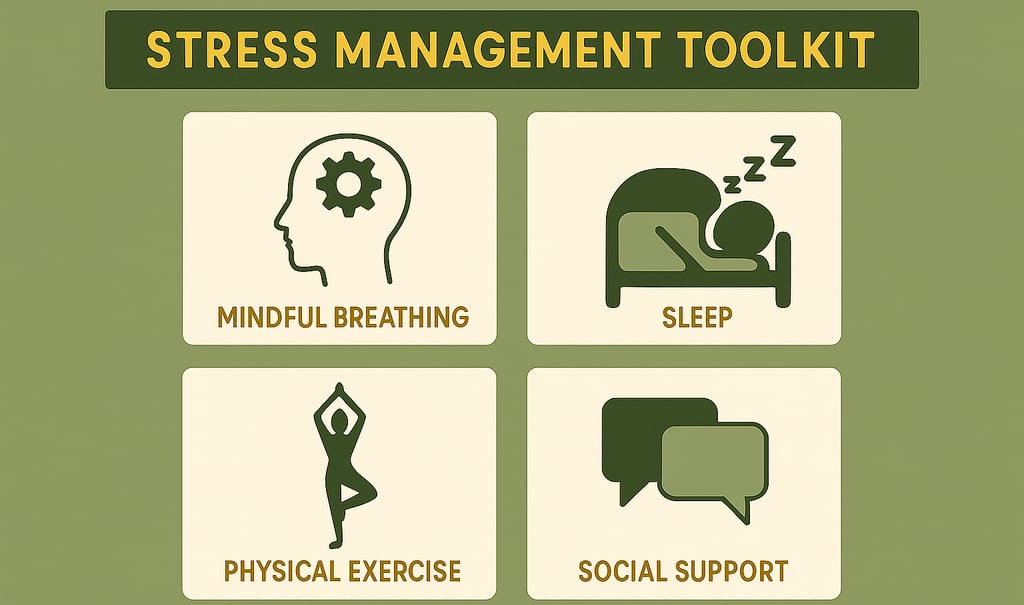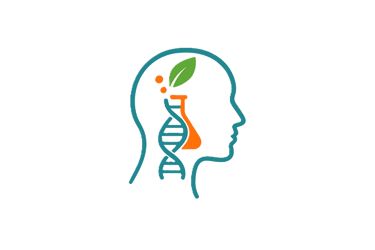5-Point Toolkit for Managing Stress — Science-Backed, Practical, and Fast to Start
STRESS MANAGEMENT
Team Alpha
11/6/20254 min read


Stress isn’t just a feeling — it’s a measurable biological state that affects sleep, energy, immunity and long-term health. Good news: a handful of evidence-based tools reliably reduce stress symptoms and shift objective physiology (cortisol, HRV, inflammation) — and you don’t need to overhaul your life to get results. Below are five core tools, what the clinical research measures, what medical experts recommend, and realistic timelines for when you’ll start to notice benefits.
1) Anchor Your Sleep: Fix the Foundation
Why it matters: Poor sleep amplifies cortisol, flattens circadian rhythms, and lowers heart-rate variability (HRV) — all markers tied to poorer stress resilience and accelerated aging. Good sleep is the single highest-leverage habit for stress recovery.
What research measures: sleep efficiency (actigraphy or PSG), cortisol rhythm (saliva), HRV (nighttime/autonomic recovery), and subjective scales (Pittsburgh Sleep Quality Index). Randomized trials show that improving sleep reduces perceived stress, daytime fatigue and inflammatory markers. Clinical guidelines from sleep medicine experts make sleep optimization a frontline intervention for stress and mood disorders.
Practical actions (science-backed):
Keep a consistent sleep schedule (same wake time ±30 min).
Create a 60-minute wind-down (no screens, dim lights, calming routine).
Avoid late caffeine and heavy meals within 3 hours of bed.
Use short-term CBT-I (cognitive behavioral therapy for insomnia) if problems persist — it’s a guideline-recommended therapy with robust RCT evidence.
When benefits appear: Subjective calm and improved alertness can begin within a few nights. Objective improvements in cortisol rhythms and inflammatory markers typically appear within 4–8 weeks with consistent sleep hygiene or CBT-I.
2) Move Purposefully: Exercise as Stress Medicine
Why it matters: Regular physical activity improves autonomic balance (↑HRV), lowers basal cortisol, reduces systemic inflammation (hs-CRP), and enhances mood through endorphin and neurotrophic pathways. Exercise is a direct, powerful antidote to chronic stress biology.
What research measures: HRV, resting cortisol, inflammatory markers (CRP, IL-6), validated mood/fatigue scales, and cognitive tests. Meta-analyses of RCTs show moderate-to-large effects of aerobic and resistance training on anxiety and depressive symptoms.
Practical actions (science-backed):
Aim for ≥150 minutes/week of moderate aerobic exercise (brisk walking, cycling) + 2 sessions/week of resistance training.
Use short high-intensity intervals (10–20 min) on busy days — these show stress-buffering effects in trials.
Schedule movement during mid-day to break up cognitive overload and reset cortisol.
When benefits appear: Acute mood boosts after a single session (minutes–hours). Consistent reductions in resting cortisol and inflammation are typically measurable by 4–12 weeks
3) Train the Mind: Mindfulness, MBSR & CBT Skills
Why it matters: Psychological interventions change both subjective experience and physiology. Mindfulness-based stress reduction (MBSR), mindfulness-based cognitive therapy, and brief CBT modules reduce perceived stress and lower biological stress markers in controlled trials.
What research measures: Perceived Stress Scale (PSS), DASS/HAM-A, salivary/serum cortisol, inflammatory cytokines, and functional brain imaging in specialty labs. Meta-analyses show small-to-moderate reductions in anxiety and depression; higher engagement predicts better results.
Practical actions (science-backed):
Start with 10 minutes/day of guided mindfulness (body scan, breath awareness). RCTs use daily practice as low as 10–20 minutes.
Try an MBSR course (8 weeks) or digital CBT program if you prefer structure. These formats have the strongest RCT evidence.
Use micro-practices at work: 60-second box breathing (4-4-4) during stressful moments to downregulate acute arousal.
When benefits appear: Immediate subjective relaxation after a single session. Robust trial-level effects on stress and mood generally emerge after 4–8 weeks of regular practice; physiological markers follow a similar timeline.
4) Eat & Supplement for Stability: Nutrition that Calms
Why it matters: Diet affects inflammation, mitochondrial energy and neurotransmitter precursors (tryptophan → serotonin). Certain nutrients and dietary patterns are associated with lower stress, reduced inflammation and better mood.
What research measures: hs-CRP/inflammatory cytokines, fasting glucose/insulin, omega-3 index (RBC EPA+DHA), and validated mood scales. Randomized trials show benefits of Mediterranean-style diets, omega-3 supplementation, and specific micronutrients (vitamin D, magnesium) on mood and stress biomarkers.
Practical actions (science-backed):
Base your plates on a Mediterranean/plant-forward pattern (vegetables, olive oil, nuts, fatty fish). Trials link this pattern to lower inflammation and better mental health.
Consider omega-3 (EPA+DHA) supplementation if diet lacks fatty fish—trials show modest anxiolytic and anti-inflammatory effects.
Use targeted supplements (magnesium glycinate, vitamin D) based on labs; avoid shotgun multitasking without testing.
When benefits appear: Subjective energy/stability can improve within 2–6 weeks; measurable reductions in inflammatory markers and omega-3 status often take 6–12 weeks.
5) Social & Systems Medicine: Boundaries, Support & Time Management
Why it matters: Social connection and perceived control are strong, independent predictors of stress resilience and longevity. Workplace design, role boundaries and recovery rituals are often overlooked but powerful.
What research measures: Psychosocial scales (perceived control, social support), cortisol rhythms, HRV, and health outcomes in epidemiologic cohorts. Clinicians and occupational therapists recommend structural changes (flexible scheduling, microbreaks) as primary prevention.
Practical actions (science-backed):
Build micro-recoveries: 5–10 minute deep-breath breaks every 90 minutes of work.
Schedule daily non-negotiable recovery (walk, family time) to protect circadian rhythm and HRV.
Invest in social time — even brief positive interactions reduce physiological reactivity.
Use time-management frameworks (time-blocking, “email windows”) to reduce cognitive switching costs.
When benefits appear: Perceived stress and subjective control can improve in days–weeks. Objective autonomic improvements (HRV) often follow in 4–8 weeks of consistent behavioral change.
Pulling it together — a 30-Day Starter Plan
Week 1: Prioritize sleep (consistent wake), add 10 minutes/day mindfulness, and take a brisk 20-minute walk 3× that week.
Weeks 2–4: Add resistance work twice weekly, continue nightly wind-down, switch to a Mediterranean breakfast, and log stress 3×/week.
After 4 weeks: Reassess — look for improved sleep quality, lower morning irritability, more stable energy. If you track HRV or sleep via wearables, you’ll often see objective shifts by week 4–8. For labs (cortisol rhythm, hs-CRP, omega-3 index), retest after 8–12 weeks.
Final note from GentHealthHub
Stress resilience is a skill you build intentionally. Combine foundational habits (sleep, movement, food) with targeted tools (mindfulness, CBT skills, social boundaries) and measure what matters. Small, consistent actions compound into measurable changes in cortisol, HRV, inflammation and day-to-day energy — and that’s how you protect performance today and longevity tomorrow.
Insights
Expert guidance for health-conscious professionals.
Support
Connect
info@genthealthhub.com
© 2025. All rights reserved.
